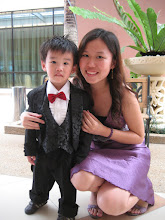11/7/2007 (Wednesday)
Today is the first day to enter this particular class of “Technology in Primary Education”. Have never thought of what it would be like, I supposed this course is all about studying the usefulness of technology in the primary school—I mean not a so interesting course that would appeal to me. However, to my surprise, this course is not just that, it is also about the skill in pleasing (PLEaSE—Personalized Learning Environment and Students Engagement) the pupils in learning through the use of technology. This realization gives me a brand new feeling towards this course. I started to gain interest in it; after all, it is so important for a teacher to “please” their pupils in order for them to learn better.
Today is the first day to enter this particular class of “Technology in Primary Education”. Have never thought of what it would be like, I supposed this course is all about studying the usefulness of technology in the primary school—I mean not a so interesting course that would appeal to me. However, to my surprise, this course is not just that, it is also about the skill in pleasing (PLEaSE—Personalized Learning Environment and Students Engagement) the pupils in learning through the use of technology. This realization gives me a brand new feeling towards this course. I started to gain interest in it; after all, it is so important for a teacher to “please” their pupils in order for them to learn better.
One thing to rise, I really marvel at how Professor Maznah kicks off the lesson by introducing the term PLEaSE. She says we need to please others if we want to get things done and on the other hand, if we are pleased, we engage well in the particular activities. Hence, since it is the 21st modern era where most of the pupils are either “digital citizens” or “digital immigrants”, teachers nowadays should know how to operate those modern technologies to bring fun in the classroom. This would please the pupils and allow more engagement in the teaching-learning process by the pupils. Basically, this is what I have learnt for this first lesson. Personally, I strongly agree with this. However, it flashes in my mind that during my School Experience Programme (SEP) in one of the primary schools at Cheras, one of the Science teachers for the Primary Year 5 classroom has ruled out the use of technology in the primary science education! Is technology not as practically important as what I have learnt today? I wonder…
According to this particular teacher, he said that pupils need to “do it by themselves” (by manipulating realias and objects, but not with technology) in order to please them and have fun in learning. Technology to this teacher is just a dull tool to be used as it does not work much on his pupils. In my opinion, though to certain extend, I agree with the teacher that hands-on experience are important for pupils to learn in fun, however the use of technology, the correct use of technology, can spice up the teaching-learning experience in primary science classroom. For instance, with the use of computer and software, the teacher can provide the pupils with concrete view on certain abstract concept, such as the motion of the moon and sun during the moon and sun eclipse. This will, according to Piaget, help in enhancing the pupils’ understanding since the primary school pupils are at the “Concrete Operational” stage. Moreover, as in the notes given by professor Maznah, Christopher (2004) has mentioned that it is the people using the technology and how they use it for what purpose that would help in learners’ learning and engagement. Hence, I do think that the primary school teacher can even use technology to provide the pupils with a variation of experience in having the hands-on activities instead of engaging them in using only mahjong paper and realias for instance. This, in my humble view, will even allow more diverse mode of teaching-learning experience that would cater to the pupil’s individual needs and to “PLEaSE” them.
To conclude, this acronym of PLEaSE is really meaningful. It brings the meaning of engagement in a lesson through the interaction among the pupils’ needs and their existing schemata, as well as the environment around. Though, I have a little wonder about the practicality aspects of using technology in primary Education, since this is the 21st century, lets us be the 21st century teachers that may cater to our pupils need in becoming the digital citizens or the digital immigrants by knowing how and why to use technologies in the Primary Education. I’m sure, one day, we will need to catch up with the footstep of globalization and be technologically well equipped in educating our future generation. So, teachers, let’s be ready with ICT! Ganbande!



















4 comments:
I love d way you write your blogs
its like you summarize the lesson for me:)
thanks for such an informative blogs (it reminds me some of the points that I forgot during the lecture ehehe)
happy blogging babe!!!
Opss, should I take it as a complement? Haha, yap, I think I should . Thanks a lot ya Miss Rahah~ Erm… this is really motivating, I think I should say it is now “Fardu-Ai” (Correct speeling? Anyway no offence o…) for me to do so, at least I know there are someone who appreciate my blogging style, thanks again...
Good job of spelling out the lessons learnt! keep up the good work
Thanks Prof for the complement. Your words are really motivating. I will try my best to strive for a even better work!
Post a Comment